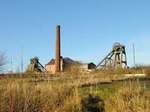
Section under development
Contents:
- > introduction
- > bed-frame
- > cylinders
- > pistons
- > valves
- > con rods
- > reversing engine
The double-acting, horizontal-duplex non-condensing engines of the North winder are of a late 19th century design, with the cylinders and cross-head guides bolted to a composite bed-frame. It is believed to be the only surviving example of a Lilleshall winding engine although examples of their pumping engines can still be seen.
It was originally designed to operate at a steam pressure of 90 psi using non-superheated steam but for several years after the new boiler range was installed at the start of the 1920s it used 150 psi superheated steam. A pressure reducing valve was later inserted in the steam main to drop this back down to 90 psi, possibly following a fracture to the bedplate.
The unjacketed cylinders are 40.5 in. in diameter with a 6 ft. stroke and were lagged (with asbestos ?) covered by light steel sheet cladding.
They are fitted with Cornish double-beat valves mounted between the cylinders. The expansion gear was of Mellings “vertical wedge” design operated by rocker shafts connected to eccentrics located between the drum and the main bearings, with the inlet cut-off activated by a centrifugal governor, belt driven from the drum shaft.
The forward & reverse eccentrics are mounted on stub shafts driven by drag-links from the big-ends. The Allan straight-link reversing gear was operated by a Mellings patent steam reversing-engine controlled by the drivers hand lever.
Cylinder lubrication was by a mechanical oiler operated from the valve rocker-shafts. The crosshead guides have sight-feed oilers, whilst other moving parts use Stauffer type grease cups.
other Lilleshall engines
Copyright © 2005 - 2020 J S. Thatcher
Page updated on:
27 Jul, 2020
at
08:22:42 PM
In case of problems contact: